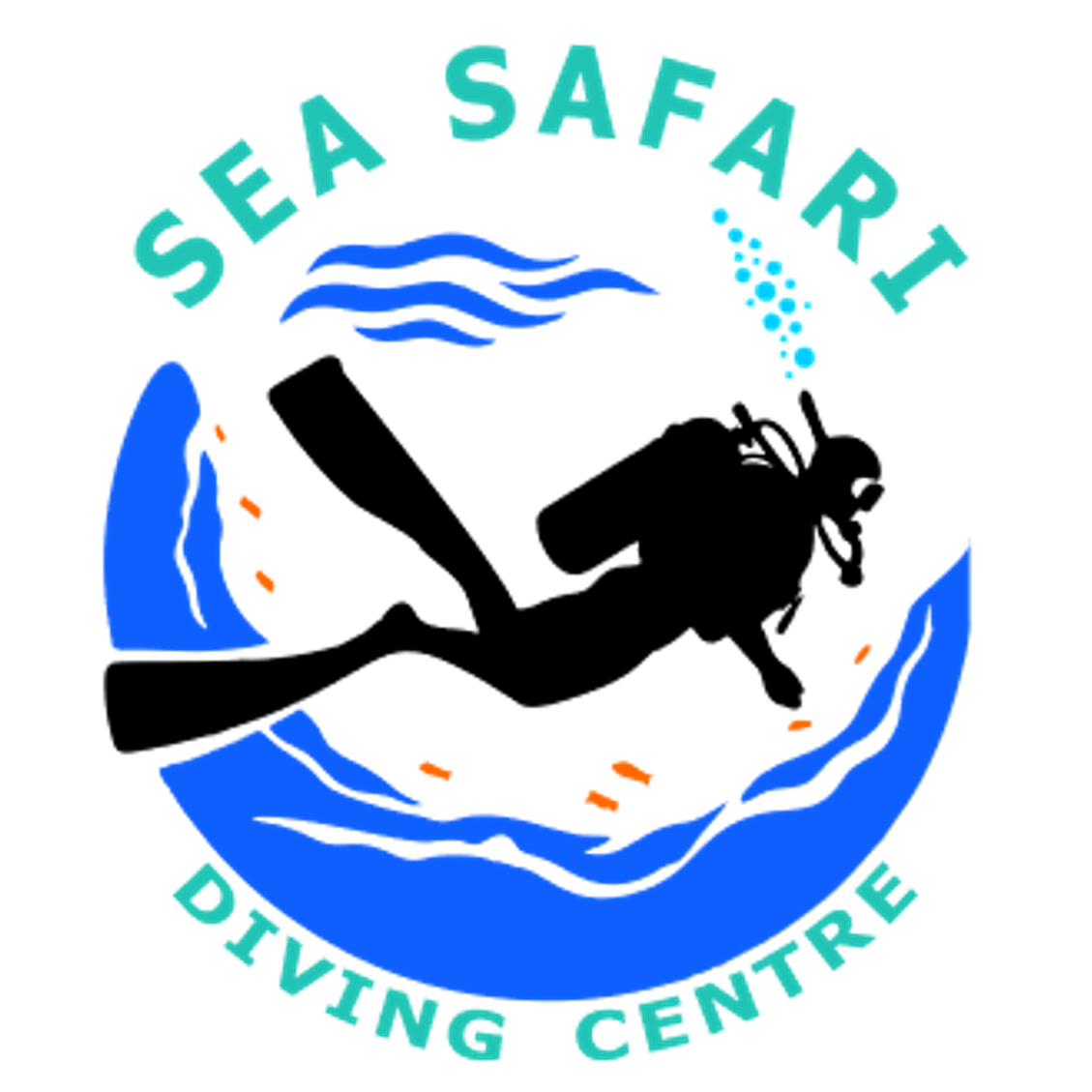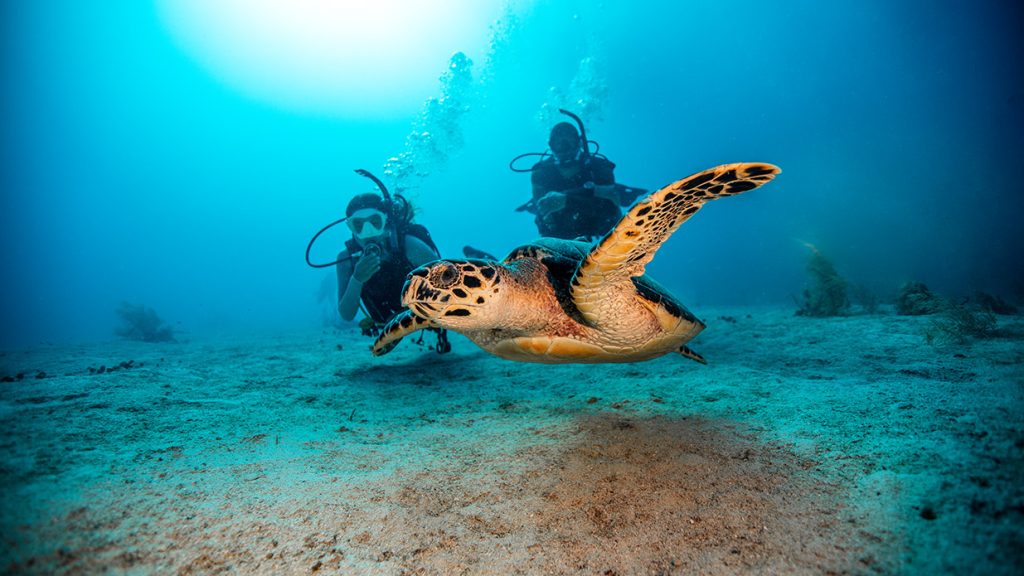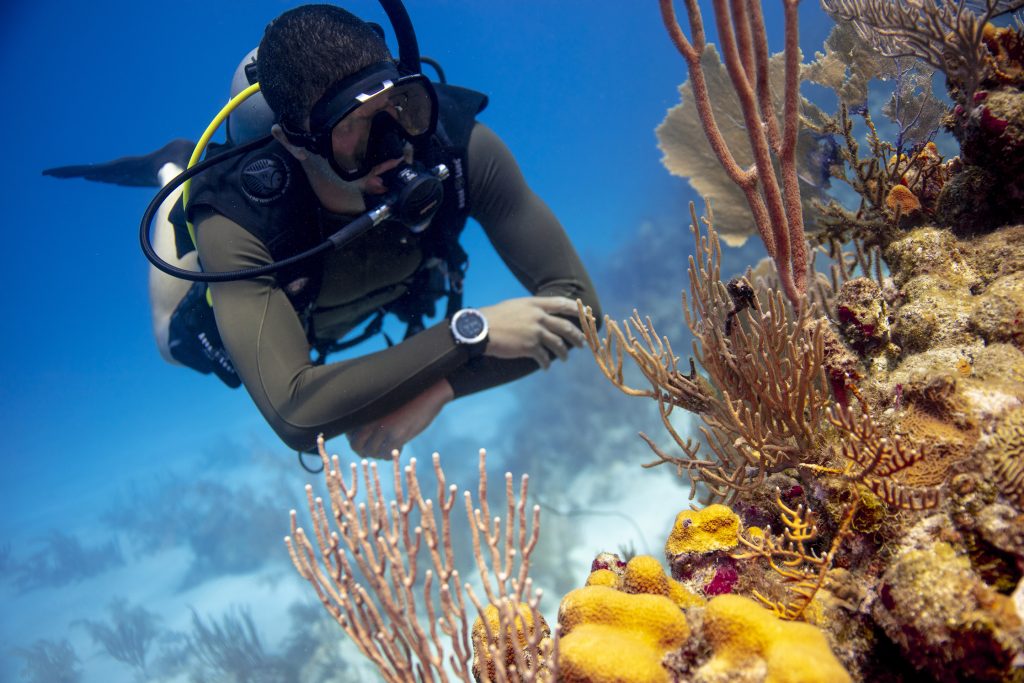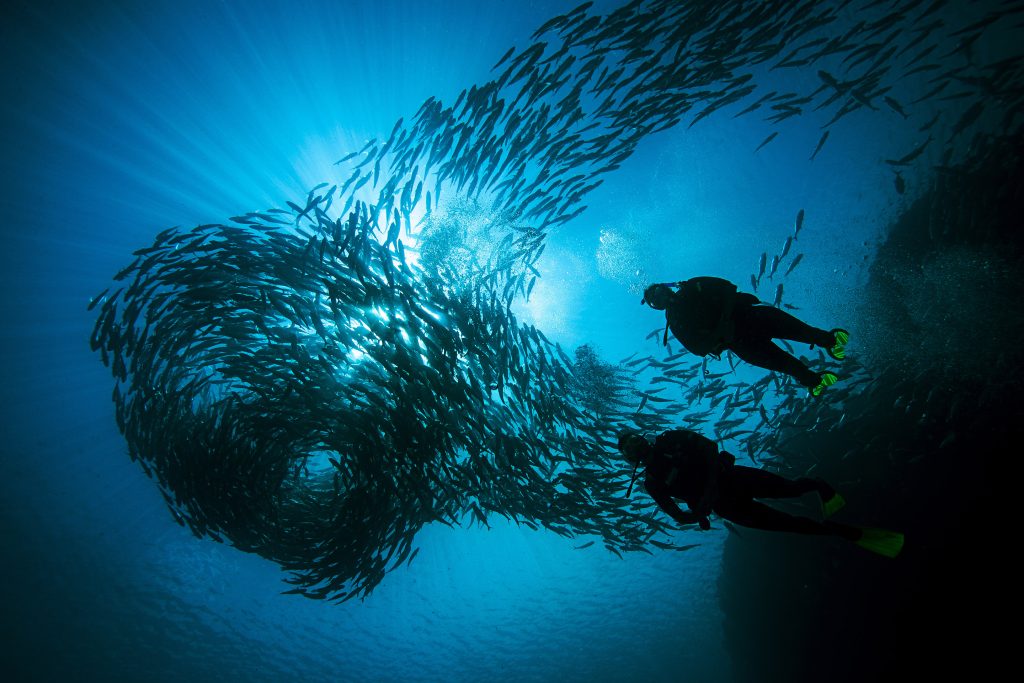Rubiah Sea Garden – Easy
An easy yet stunning dive that follows the contours of Rubiah Island, this site offers a beautiful variety of underwater scenery. Begin over white sandy bottoms with dramatic black granite formations rising like underwater castles, then drift onto a gentle slope dotted with hard coral bommies, home to stingrays, giant clams, turtles, and a colourful mix of reef fish. Shallow up towards the island’s edge to explore lush soft coral gardens, or continue out across fields of garden eels and striking rock structures. Keep an eye out for honeycomb moray eels—either nestled in crevices or swimming freely with cleaner wrasse in pursuit. Rare and curious species like flying gurnards, ghost pipefish, and leaf scorpionfish make occasional appearances, while the ever-entertaining clown triggerfish and Pulau Weh’s favourite reef residents are always close by..
Rubiah Jetty – Easy
A perfectly controlled and safe place to begin your scuba diving adventure. This site features a gentle sandy slope bordered by fringing hard corals, with deeper areas revealing staghorn coral fields. Rubiah Jetty is teeming with life—expect to see colourful reef fish alongside lionfish, scorpionfish, trumpetfish, pufferfish, and blue-spotted stingrays. Several artificial reef structures have also been placed here, providing both shelter and feeding grounds for marine life, and encouraging coral growth. It’s an ideal training site, but still rewarding for experienced divers. And when you surface, why not fly high on the famous ocean swing or take a scooter ride to Kilometer Zero—just part of the magic around Rubiah.
Rubiah North – Medium to challenging
Begin at the northern tip of Rubiah Island and follow the slope through a striking landscape of giant granite boulders. The area is rich with marine life—gorgonian sea fans stretch endlessly across the deeper sections, while soft coral whips line the embankments. Keep your eyes peeled for nudibranchs, stingrays, and a variety of moray eels, including the striking honeycomb moray. Schools of snappers and fusiliers swirl through the currents. On calmer days, confident divers can cross the channel to end the dive at Arus Paleh, where big-nose unicornfish often follow divers, chasing bubbles. If the current is strong, return to the sheltered shallows of Rubiah Utara, where painted rock lobsters and pygmy snappers hide among the reef.
Arus Baleh – Medium to challenging
A dramatic pinnacle between Rubiah and Seulako Islands, Widow’s Current is known for its powerful flow and exciting marine life. The site is bordered by a deep channel to the south and a shallow channel to the north, creating dynamic conditions that attract pelagics and reef fish alike. Hook into the reef and watch blacktip reef sharks cruise by, or descend into shimmering clouds of fusiliers as bluefin and giant trevallies hunt through them. Big-nose unicornfish often follow divers, playfully chasing their bubbles. Both the eastern and western slopes are teeming with reef life, including moray eels and vibrant corals. The western slope is a great place to spot blue ribbon eels and their striking black juveniles. In deeper areas, giant sea fans cover the channel floor, while seasonal visits from devil rays add to the spectacle. More regular sightings include reef sharks and giant grouper. In the sheltered shallows, look out for large porcupine and pufferfish resting among colourful anthias.
Seulako Cave – Easy to medium
This captivating site features a series of overhangs and shallow caves teeming with life. Small glassfish shimmer in the shadows, joined by large batfish, sea fans, corals, and colourful reef fish. Before reaching the caves, the slope from Seulako Island reveals oriental sweetlips, ribbon eels, porcelain crabs hiding beneath anemones, and more. Layers of anthias, red-tooth triggerfish, and surgeonfish dart for cover when bluefin and giant trevallies sweep in to hunt. When the current picks up, reef sharks often patrol the shallow channel before the caves. Nudibranchs, octopus, leaf scorpionfish, lionfish, and various moray eels are regular highlights. Finish your dive in the shallows with a dazzling light show as fusiliers twist and flash away from predators.
Seulako Drift – Easy to medium
The gradual slope of Seulako Island makes this a relaxed and rewarding drift dive, often allowing for a full circuit of the island when conditions are right. Begin in the south among vibrant hard corals, then drift north through fields of soft elephant ear corals and anemones. Along the way, spot countless moray eels, spotted stingrays, and the occasional large yellow boxfish. Resident reef sharks glide by, but the real highlight is the devil rays—often seen in groups of 20 or more, cruising effortlessly in formation. Keep an eye out for giant grouper and marble reef rays, both regular visitors to the site. Under the coral bommies, varieties of sweetlips rest among swaying Christmas tree worms, completing this vibrant underwater journey.
Batee Tokong – Easy to challenging
At times, the reef is almost hidden beneath the sheer number of fish—this site is truly alive. Begin your descent along the first wall, where you’ll quickly lose count of the many moray eels and marvel at the incredible variety. Towering gorgonian sea fans line the deeper walls of this impressive pinnacle, which is rich with marine life from top to bottom.
Reef sharks are frequently seen near the adjacent Shark Plateau, and during strong currents, barracudas, bigeye trevally, and even more sharks rise up from the depths. Massive dogtooth tuna cruise alone through the blue, while bluefin and giant trevallies hunt in coordinated bursts across the reef.
The diversity continues with nudibranchs, octopus, lionfish, and vibrant anemones. Several species of sweetlips—including giants—are regulars, and giant frogfish often lurk along the deeper walls. When the season is right, flocks of devil rays glide past in numbers too high to count—and if you’re lucky, a manta ray might make a surprise appearance.
Shark Plateau – Challenging +
A thrilling dive for experienced divers, Shark Plateau offers deep water, strong currents, and big encounters. Descend into the blue through swirling schools of barracuda and bigeye trevally to reach the top of the plateau. The sides drop off into seemingly endless depths, draped in sea fans, while the plateau itself is dotted with barrel sponges and hard corals. Giant groupers, reef sharks, and rays—manta, eagle, and devil—are frequent visitors, adding to the excitement. This site often connects to Batee Tokong, where the dive can finish among vibrant reef fish and dramatic underwater topography. A must-dive for those seeking Pulau Weh’s big action.
Batee Gla – Easy to challenging
A dramatic underwater peninsula formed by towering granite boulders is the highlight of this stunning dive site. The southern side features a flat sandy bottom dotted with large coral bommies, home to a variety of reef fish and stingrays. As you descend deeper, you’ll be surrounded by swaying garden eels and the occasional passing turtle. Drift along the slope in search of ribbon eels, honeycomb morays, and lionfish. At the tip of the peninsula, check beneath the boulders for harlequin and oriental sweetlips. On lucky days, manta rays, bumphead parrotfish, and turtles make unforgettable appearances. This dive can also begin from the northern wall of the peninsula, where clear conditions reveal sweeping underwater vistas that seem to stretch on forever.
The Canyon – Medium to challenging
Twin pinnacles rise from a seafloor draped in giant sea fans, forming a dramatic canyon between them. Divers drift over rippling fans toward a northern swim-through, surrounded by soft corals in pale blue, yellow, and white—like snowfall softening the edges of this underwater landscape. The canyon teems with life: schooling bannerfish, unicornfish, gold-saddle goatfish tumbling down the vertical walls, plus barracuda, trevally, snapper, emperors, octopus, and nudibranchs. Along the eastern slopes, watch for eagle rays, devil rays, or manta rays emerging from the deep blue. The western faces of the pinnacles form a sheer amphitheatre, often hosting turtles and massive napoleon wrasse. The dive finishes through a channel leading back to the shoreline, where granite boulders are crowned with table and hard corals. In the shallows, schools of tangs and surgeonfish shimmer like moving rainbows. Look closely in the deeper sandy areas—zebra sharks often rest here, and lucky divers may even spot a mola mola when cold, deep water currents rise during certain times of the year.
Pantee Peunateung – Medium to challenging
ot for the faint-hearted, this is an adrenaline-fueled dive site known for its powerful currents and breathtaking marine life. Vertical walls begin at 25 metres and plunge beyond 40, curving into a dramatic half-moon shape around which the current can surge.Tornadoes of bigeye trevally spiral up from the depths, sometimes by the thousands—swim into the centre and feel the rush as you move with the school. Massive barracuda cruise effortlessly through the current, while napoleon wrasse and even hammerhead sharks have been sighted here.The sheer walls are draped in sea fans and corals, with triggerfish and fusiliers rising and falling like clouds—nature’s gauge for current strength. In the shallows, rice-terrace-like ledges are covered in hard coral, home to milkfish, swimming morays, lionfish, octopus, nudibranchs, and a variety of reef fish.Marble rays and eagle rays glide past regularly, and your safety stop may take you straight into a swirling ball of jacks—an unforgettable end to an unforgettable dive.
Batee Meuroron – Medium
This tiered, sloping dive site is shaped by large granite boulders that rise above the surface, forming a dramatic underwater landscape. At the shallow tip of the granite peninsula, strong currents often attract black snappers and bluefin trevallies hunting among clouds of fusiliers. Follow the reef back toward the sandy bay, where electric rays and giant groupers may be spotted lurking near the bottom. In the shallower coral gardens, reef fish, stingrays, and busy little shrimps make this area vibrant and full of life—perfect for ending your dive on a calm and colourful note.
Gapang Beach – Easy
A favourite for macro enthusiasts, Gapang Beach offers a gentle white sandy slope dotted with staghorn fields and clusters of hard corals—perfect hiding spots for all kinds of marine life. Among the usual reef residents like lionfish, parrotfish, triggerfish, shrimpfish, and pufferfish, sharp-eyed divers can uncover a world of hidden treasures: shrimps, crabs, octopus, and cuttlefish often lie in wait beneath the coral. But the real draw? Rare and elusive species like rhinopia (a type of scorpionfish), frogfish, and seahorses—perfect for the patient underwater photographer or curious explorer.
Batee Dua – Easy to medium
These twin pinnacles are draped in anemones and vibrant corals, creating a colourful backdrop for a diverse range of marine life. The drop-off leads to a sandy field of garden eels swaying gently in the current, while the return to the shallows reveals schools of sleek unicornfish and countless varieties of reef fish. Peer into crevices packed with glassfish to spot twinspot lionfish and several species of moray eels. On the sandy bottom, large stingrays lie buried, with only their eyes and tails peeking out. Keep an eye on the blue—devil rays and eagle rays often glide past overhead, offering unforgettable sightings.
Limbo gapang – Easy to medium
Take a relaxed turn around this gentle sea mound, where hard corals and rocky overhangs provide perfect hiding spots for spotted stingrays and moray eels—including the striking fimbriated variety. On the shallow reef top, eagle rays sometimes glide by, while anemones sway and curious octopus rise to investigate. Look up and you might catch large barracuda circling overhead, with rivers of blue-streak fusiliers streaming past. During your descent and ascent, you’ll be surrounded by schools of sleek unicornfish and red-tooth triggerfish. And for the sharp-eyed diver, a special treat awaits: the resident leaf scorpionfish, perfectly camouflaged and always worth the search.
Underwater volcano – easy
A truly unique dive experience, this shallow site features a natural underwater hot spring where bubbles rise from cracks and fissures in the seabed. Enjoy the gentle warmth near the source—but be prepared for a hint of sulphur at the surface! Despite the unusual conditions, marine life thrives here. Look out for five-lined snappers, map pufferfish, and small groupers that have adapted to this otherworldly environment. A short, easy dive with a one-of-a-kind atmosphere.
Sophie Rickmers Wreck – Challenging ++
A spectacular deep wreck dive reserved for highly certified and experienced divers, The Sophie Rickmers is a planned stage decompression dive that promises drama, history, and unforgettable underwater scenery. This WWII-era German cargo ship was scuttled in 1940 to avoid capture by the Dutch. Today, she lies upright and largely intact, her massive structure encrusted with healthy corals and teeming with deep-water marine life. Giant groupers and marble rays are frequent visitors, and curious batfish often escort divers around the wreck. The hull and superstructure are alive with reef fish, and large scorpionfish hide in plain sight—so mind your hands. With visibility often reaching 40 metres, this dive offers an extraordinary experience rich in history and marine biodiversity—an absolute highlight for technical divers.
Batee Meuduro – Challenging +
A dive for experienced divers only, this is an exhilarating deep-water pinnacle known for its strong currents and thrilling marine life encounters. Accessed by a deep drift entry, this site takes you flying through the blue with the chance to spot eagle rays, napoleon wrasse, barracudas, reef sharks—and with luck, even a rare thresher shark. As you circle the pinnacle, make your way up into the sheltered shallows, where expansive table corals stretch across the reef and vibrant reef fish add a burst of colour to your safety stop. A high-adrenaline dive that rewards confidence, control, and keen eyes.
Anoi Hitam – Medium
This well-rounded dive site offers all the classic marine life you’d expect from Pulau Weh—reef fish, moray eels, lionfish, and more. But the real charm lies in the small cave at its centre, where macro enthusiasts will find plenty to explore, including a variety of nudibranchs and other hidden treasures. Begin the dive with garden eels gently swaying as they feed in the sand, and finish among graceful whip corals—giving the site a natural symmetry and a satisfying dive experience for all skill levels.





